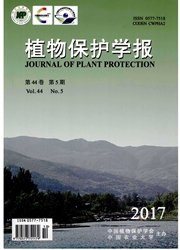

 中文摘要:
中文摘要:
为了评价3种PCR分子检测体系对柑橘黄龙病(citrus huanglongbing,HLB)大田诊断效果,综合比较了常规PCR、巢式PCR和SYBRGreenI荧光定量PCR(SGI—qPCR)方法对柑橘黄龙病菌检测的灵敏度、特异性和准确度等参数,并用SYBRGreenI荧光定量PCR和巢式PCR监测广西柑橘园疑似HLB样品425个,比较了2种检测体系的阳性检出率。基于CQULA04F/CQULA04R引物对的SYBRGreenI荧光定量PCR的灵敏度可达10ag/μL;而巢式PCR灵敏度为100ag/μL,巢式PCR较常规PCR检测灵敏度高10^4倍。疑似样品的HLB病原SYBRGreenI荧光定量PCR和巢式PCR检出率分别为46.6%、40.0%。各检测体系的灵敏性、特异性、符合度依次为SYBRGreenI荧光定量PCR〉巢式PCR〉常规PCR。研究表明,SYBRGreenI荧光定量PCR可作为果园大规模HLB早期诊断和监测的首选,而在缺乏定量检测仪器时,巢式PCR也可用于HLB的检测.但需注意避免空气污染导致的假阳性。
 英文摘要:
英文摘要:
In order to provide practical detection approach for early diagnosis and dynamic monitoring of citrus huanglongbing (HLB) pathogen. The sensitivity, specificity and accuracy of 3 type PCR approa- ches were compared. Total 425 suspected citrus samples with or without symptom of HLB from plantation of Hepu County, Guangxi were amplified and confirmed by nested-PCR and SYBR Green I -qPCR ( SG I -qPCR). The effectiveness and the positive rates of the two PCR were evaluated. The results showed that the detection sensitivity of SG I -qPCR for HLB pathogen DNA was 10 ag/μL, while was 100 ag/μL for nested-PCR. Conventional PCR detection sensitivity was 104 times lower than nested-PCR method. Positive rate percent of detection for suspected citrus samples were in 46.6% and 40.0% by SG I -qPCR and nested-PCR, respectively, which indicated that SG I -qPCR was able to provide more accurate diag- noses than nested-PCR. The sensitivity and veracity of conventional PCR, nested-PCR and SG I -qPCR system were enhancing in turn. Practically, SG I -qPCR should be concerned priority selection in large scale early diagnosis and dynamic monitoring in citrus plantation. As the PCR instrument of quantitative detection not available, nested-PCR could be used for better detection of HLB as long as well controllingof the air pollution of amplified procedure, in order to prevent the false positive amplification.
 同期刊论文项目
同期刊论文项目
 同项目期刊论文
同项目期刊论文
 期刊信息
期刊信息
